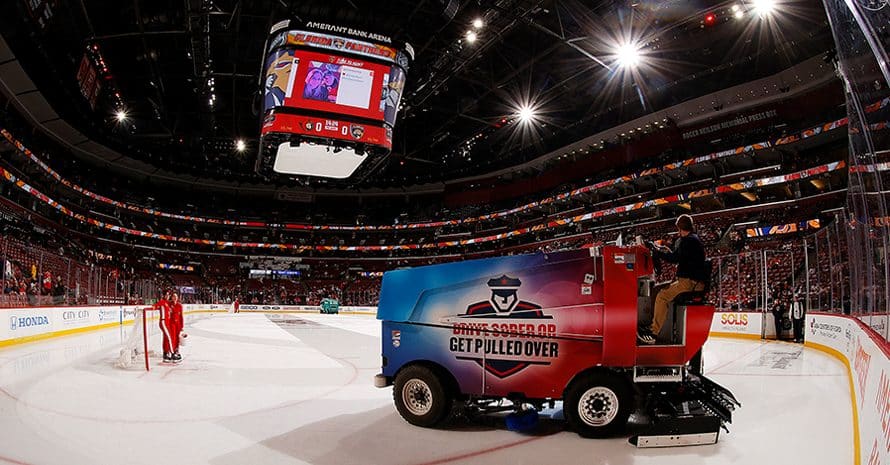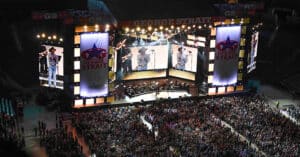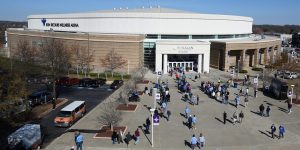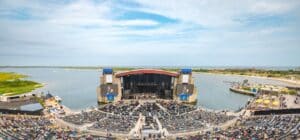ICE AND SHINY: A Zamboni driver for the Florida Panthers refreshes the ice surface at Amerant Bank Arena for an NHL game in April against the Ottawa Senators in suburban Fort Lauderdale. (Getty Images)
Family-owned biz stretches four generations
Happy 75th birthday to Zamboni, which today celebrates its diamond anniversary on the ice.
The rich history behind the ice resurfacing machines, tied to one of the most iconic brands in sports and whose mechanism fascinates spectators of all ages, started on May 16, 1949. That’s the day when Frank J. Zamboni, an entrepreneur and inventor of multiple products, applied for a U.S. patent for his invention. It came together in of all places, an ice rink he built in Paramount, California that originally opened as an outdoor facility before installing a roof several months later.
“The assumption is that it’s always been a cold weather climate invention,” said Mike Zamboni, engineering product development manager for Zamboni Company, representing the fourth generation of the family working for the firm. “One of the fun aspects of the story is that its birthplace is somewhere you wouldn’t expect it to be.”
Seventy-five years later, after producing thousands of machines for use across the globe, Zamboni Company carries 121 full-time employees distributed among manufacturing plants, sales and customer service locations in California, Brantford, Ontario, Sweden and Quebec.
Mike Zamboni is the great-grandson of the company’s founder. Mike’s father, Frank Zamboni, the firm’s president, was born in Cheyenne, Wyoming and raised in California, before moving to Canada in 1983 to restart the Canadian operation after Zamboni Company ran a small manufacturing operation in Paris, Ontario from 1967-75.
Richard Zamboni, second generation and son of Frank J. Zamboni, is 91 years old, but is no longer active in the business.
Five years ago, Mike Zamboni, a 31-year-old Toronto native, joined Zamboni Company after working a few years doing electrical engineering at a firm that designed circuit boards. In high school, Mike worked summers at the Brantford plant, but initially thought his professional career would take him down a path in the academic world.
“I was a big science and math nerd, thinking I would study and get my doctorate at some point,” he said. “I didn’t envision myself working at the family business at that time. I studied engineering with a minor in business at McMaster University in Hamilton, and we did a few projects with (Zamboni), which required us to work with a business that could provide us with a problem to solve.”
There was never any pressure from Mike’s family to get him to work for Zamboni, which was a good thing, he said, because it allowed him to explore his interests outside of their core biz and map out his future. He eventually changed his mind after getting a call from Zamboni’s vice president of operations to inform him of opportunities in business development overseas, pursuing a growing segment of the market in Asia for ice resurfacing machines.
“I figured out what I liked to do and what I was good at doing, and a lot of that jibed with the needs of the business at the time that I came on board,” Mike said. “It let me find my way to the business and figure out how I can contribute in a meaningful way without pigeonholing myself into a role at the company that might not have been a good fit.”
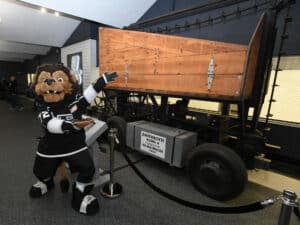
IT’S AN ORIGINAL: Los Angeles Kings mascot, Bailey, poses next to the original Zamboni ice resurfacing machine at the reopening of LA Kings Iceland at Paramount in October 2022 in Paramount California. (Getty Images)
As it turned out, Mike Zamboni’s role extends to touching all branches of the business that work with the company’s machines, from engineering to sales and customer service.
Shortly after he joined the firm, the pandemic shut down the sports and entertainment industry. The shutdown affected sales and production, delaying some projects and accelerating others at the same time, given the COVID-19 restrictions in place in California and Canada.
“It required the team to be on its toes, and it was a learning experience for me to understand how a company is able to deal with adversity,” he said.
These days, Zamboni Company’s business is booming to match the surge in sports venue development, Mike said.
Family leadership helped prepare for this point. Over the past eight years, Zamboni acquired its two longtime distributors in Sweden and Quebec. At the start of 2024, Zamboni purchased Jet Ice, the dominant leader in ice paint, in-ice logos and water treatment systems since 1979, a strategic acquisition that expands Zamboni’s services and further strengthens the brand as a leading expert in ice surfaces.
As technology has evolved, so has Zamboni’s product line. Forty years ago, Zamboni was way ahead of the curve, producing electrical-powered machines with lead acid battery systems. But it wasn’t until the past few years, when there came an inflection point in the industry, as more customers steered toward electrical machines as part of the sustainability movement in sports.
Part of it, too, was the overall push toward cleaner air in ice arenas, Mike said. The newer technology, using lithium ion batteries, produces zero emissions compared with lead acid batteries that leave vapers, as well as internal combustion engines powered by propane tanks.
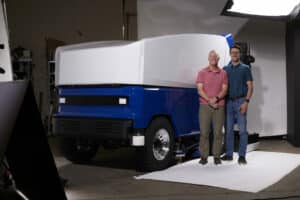
ZAMBONI WITH A Z: Mike Zamboni, right, stands with his father, Frank, next to the ZX5 prototype, the next generation of ice resurfacing machines. (Courtesy Zamboni Company)
Zamboni’s newest machine is the ZX5, which effectively automates the process of adjusting the resurfacer’s shaving blade, which is used to manage the thickness of the ice. The ZX5’s laser system allows the machine to self-manage the thickness to a high degree of accuracy, which results in a perfectly flat sheet of ice and ensures venues and operators don’t have a thicker sheet of ice that can lead to higher energy costs.
The new model is another function of the green movement in sports, Mike said. A limited quantity of the ZX5 model will be produced this year at a cost of about $150,000 before full production begins in 2025.
The ZX5’s innovations expand on the 500 series machines that have provided a strong platform for Zamboni Company over the past several decades. The lifespan of a machine depends on the venue, how much the ice resurfacer is used and how diligent the customer is for doing routine maintenance, which can now be monitored through Zamboni Connect, a mobile application that tracks consumption and provides support services.
In general, Zamboni machines are replaced every 10 years, but some customers are still running the company’s ice resurfacers that are more than 30 years old, Mike said.
As technology reshapes the controls and operations for Zamboni products, will there come a time when the company produces a self-driving ice resurfacer?
It’s something Mike Zamboni must consider as part of his job, at a time when many Zamboni drivers are retiring, which is part of what’s driving advances in automation such as managing the ice shaving blade, to help make it a bit easier to train the operators, he said. It’s left a big gap in talent for those specialized occupations, although the company’s “boot camp” training sessions in Brantford help offset the loss of experienced operators.
“Down the road, there’s an opportunity for a self-driving machine to give venues the ability to manage their ice more effectively and have their staff focus on other things in the facility,” Mike said. “It’s not as simple as putting it out on the ice to help reduce your workforce. There’s a lot more that goes into making sure it’s safe; it’s a holistic solution. The goal is not to take anybody’s job away, but to provide them with a better tool for managing the ice.”
